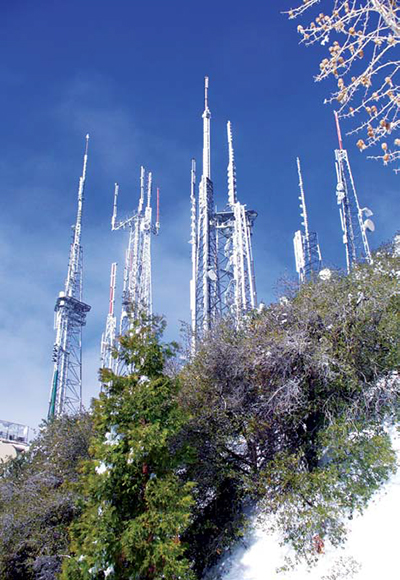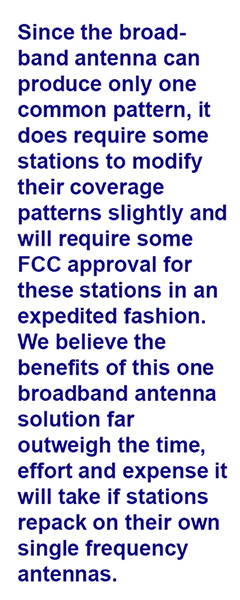Q&A: Peter Starke on Repacking on Broadband Antennas

BOSTON—The Federal Communications Commission released its proposed plan for the post-incentive auction TV channel repack, an undertaking in which 1,200 to1,400 broadcasters will have to move to new channels. The commission is proposing to use a market-by-market approach, in which stations transition by their given designated market area. (See “FCC Repack Plan: Key Points,” Oct. 5, 2016.)
The proposal mentions American Tower Corp.’s Broadband Antenna Initiative as a possible “solution that would reduce reimbursement costs” or otherwise be independently developed by broadcasters within a market. TV Technology’s Deborah McAdams reached out to ATC’s vice president of broadcast, Peter Starke, to provide an overview of the Broadband Antenna Initiative and how it’s being implemented in Los Angeles.
TV Technology:The FCC specifically called out American Tower Corp.’s Broadband Antenna Initiative in its repack proposal, outlined in the recent Transition Scheduling Plan Public Notice. Would you describe the basics of this proposal, and why it’s important?
Peter Starke: The proposed post-auction channel allocation, 39-month repack channel construction permit (CP) application, reimbursement cost estimating and construction period creates a host of planning, preparation and implementation challenges.
Repack stations can use ATC’s existing and proposed broadband antenna systems as a cost-effective, channel-agile, expedited construction solution. A single, properly planned, designed and built broadband antenna in certain Designated Market Areas can possibly handle all of that market’s repack transmission needs.
We have also factored in next-generation TV by proposing the addition of vertical polarization for enhanced ATSC 3.0 reception to all devices.
TV Technology:Does this allow more stations to transmit from the same tower?
Starke:Yes. We are working with our current TV tenants on potential repack transmission solutions. ATC operates 174 towers with at least one main full-power or Class A TV license. Of these towers, 74 have multiple full-power and Class A licenses.
Most of these sites fall into the “complex” category, with candelabras supporting both TV and FM antennas. Our Broadband Antenna Initiative offers a single antenna solution for our current TV tenants who are challenged with limited tower space for additional multiple single frequency antennas.
We are also reaching out to TV licensees in DMAs where there may be broadband antenna solutions on ATC sites. Cost-efficient and expedited solutions can potentially include the use of one of our existing 29 UHF broadband antennas or new broadband antennas. Our broadband antenna plans include both permanent and transitional channel scenarios.
We intend to provide operational capability on pre- and post-assignment channels (i.e. UHF 14 to 51) for maximum flexibility.
TV Technology:ATC’s Aug. 31 ex parte filingwith the FCC notes six broadband antenna DMAs “in development,” another five “under review,” and eight more in the “pipeline.” Los Angeles is at the top of the first list. L.A., the second largest DMA in the United States, primarily is served by TV towers on Mt. Wilson (pictured above) and nearby Mt. Harvard in the San Gabriel range. How would ATC’s Broadband Antenna Initiative be deployed in the L.A. market, and how would this impact the timing of the repack as well as coverage patterns?

Starke: The Mt. Harvard and Mt. Wilson TV and FM broadcast transmission facilities are very congested. All towers and transmitter buildings are tightly packed on very small adjacent parcels. Even today’s minor tower and construction maintenance work has its own micro daisy chain and interdependency challenges. Any repack construction at these sites will require prolonged TV and FM over-the-air outages.
Although the towers are not that tall by broadcast standards, complex rigging will be required at most sites due to the crowded towers, buildings and antenna configurations.
Many of the Mt. Wilson facilities are on U.S. Forest Service land. We have analyzed all of the logistical challenges of trying to build out for repack at the current facilities. During these site-by-site analyses, it became clear that our Deer Park tower facility offers the best repack solution for the L.A. DMA.
Deer Park is on Mt. Wilson, but situated on private land 2,000 feet to the west of the existing Mt. Wilson tower cluster. It is the former KCBS-TV analog transmit facility. The tower is 900 feet AGL [above ground level], 6,629 feet, AMSL [above mean sea level], making it the tallest broadcast tower on Mt. Wilson and Mt. Harvard.
We plan to remove the existing top-mounted decommissioned analog VHF antenna and install a high-power broadband UHF antenna with dual feedlines and tunable polarization.
The existing transmitter building will be renovated to support up to nine full-power stations. Of importance to minimize regulatory approvals, there will be minimal ground disturbance and no increase in tower height.
This broadband UHF antenna project will; a) permit shared costs amongst participating stations, b) reduce regulatory approvals and timing, c) provide ATC project management, d) virtually eliminate OTA downtime e) provide a common pattern and coverage.
Since the broadband antenna can produce only one common pattern, it does require some stations to modify their coverage patterns slightly and will require some FCC approval for these stations in an expedited fashion. We believe the benefits of this one broadband antenna solution far outweigh the time, effort and expense it will take if stations repack on their own single frequency antennas.
TV Technology:What else should readers know about ATC’s Broadband Antenna Initiative?
Starke: I see broadband antennas playing a major role in channel transitions during the time- and cost-constrained repack construction period. They offer stations the flexibility of operating on their current and/or repack channels, both for main and auxiliary/transitional transmission.
Broadband antenna projects will minimize over-the-air disruption, provide shared lower repack costs per channel, and aid in meeting the buildout and eligible reimbursement deadline. In addition to adding v-pol for ATSC 3.0, a common coverage broadband antenna pattern will give stations a high-power nucleus site for future design and deployment of common antenna Single Frequency Network sites throughout each DMA.
ATC is working closely with the FCC, broadcast industry consulting engineers and TV licensees on common broadband antenna contour deployment, regulatory planning and approvals.
TV Technology:What is ATC doing with regard to the relocation reimbursement process?
Starke: ATC has been diligently planning for the post-repack channel allocation world. We have developed multiple repack implementation options for our high repack probability tower sites.
ATC has the herculean task of providing repack CP application planning guidance and estimated eligible tower site reimbursement costs during the post-channel allocation 90-day surge on all our towers.
We are developing a “war-room” team structure to analyze all tower sites once the reverse auction winners and repack channel allocations are announced.
Our broadcast administration and legal teams are developing a repack customer program to handle the influx of post-auction channel allocation tower lease amendments and rewrites. Our repack services team has developed a “Scope of Repack Services” program.
This program closely matches the Widelity “Catalog of Potential Expenses and Estimated Costs.” It provides each repack station the “easy button” for completion of the 90-day milestones, pre-construction work from application through Notice to Proceed (NTP). We are also offering some construction management services.
TV Technology:The commission’s repack proposal leans away from granting temporary channel assignments and reimbursing costs for temporary facilities. How might this impact a station with a top-mounted antenna and no other tower options?
Starke: It will be necessary for stations to have some type of temporary, or what I call a “transition,” RF system, in order to remain on the air with their current channel while building out their new channel RF systems.
Another challenge is the planning, cooperation and cost associated with temporary facilities for third-party broadcasters impacted by a repack station. While the auction “quiet period” has slowed down our planning discussions with TV groups, there could be multiple options for how they may handle the transition and cutover of their single frequency RF systems.
For example, stations may prefer to keep their current channel top-mounted and side mount a new channel “transition” antenna for the cutover, then build out their new channel antenna on the top of the tower.
Or they may prefer the opposite—immediately replace their current channel top-mount antenna with their new channel antenna and side mount a “transition” antenna for their current channel to remain on the air through the cutover date. Stations that participate in ATC’s Broadband Antenna Initiative will have a much clearer path and greater flexibility in deciding how they want to handle the cutover with minimal or no OTA downtime.
TV Technology:How many stations likely will need to rely on a temporary facility at a clearing target of 114 MHz?
Starke: Whether single frequency or broadband, temporary RF facilities will be required for most stations in order to remain on the air and prepare for the cutover.
We have worked closely with the antenna manufacturers on transition antenna solutions that offer low wind load, reasonable costs and agile frequencies.
For example, Dielectric developed the TFU-WB antenna. This is a side-mount design, broadband, low-wind load UHF antenna offering multiple patterns and power handling. RFS, Kathrein as well as others have developed new broadband antennas.
Use of existing broadband or new broadband antennas offers the greatest flexibility for remaining on the air and transition to new channels.
Based on the 114 MHz clearing target, ATC owns and/or operates:
- 357 Full Power and Class A stations operate on owned, managed, & leased sites (165 stations Ch. 32 and higher)
- 181 towers with ALL FP and Class A service types – DT, DC, DX, DD
- 174 towers with at least one Full power/Class A TV
- 74 towers with 2+ Full Power/Class A TV
- 108 towers with channels Ch. 32+
- 65 “Complex” sites (Candelabra, Mountaintop, Broadband Antenna)
- 29 owned and operated Broadband UHF antenna systems
- 97 DMAs with towers supporting TV transmission
The professional video industry's #1 source for news, trends and product and tech information. Sign up below.
